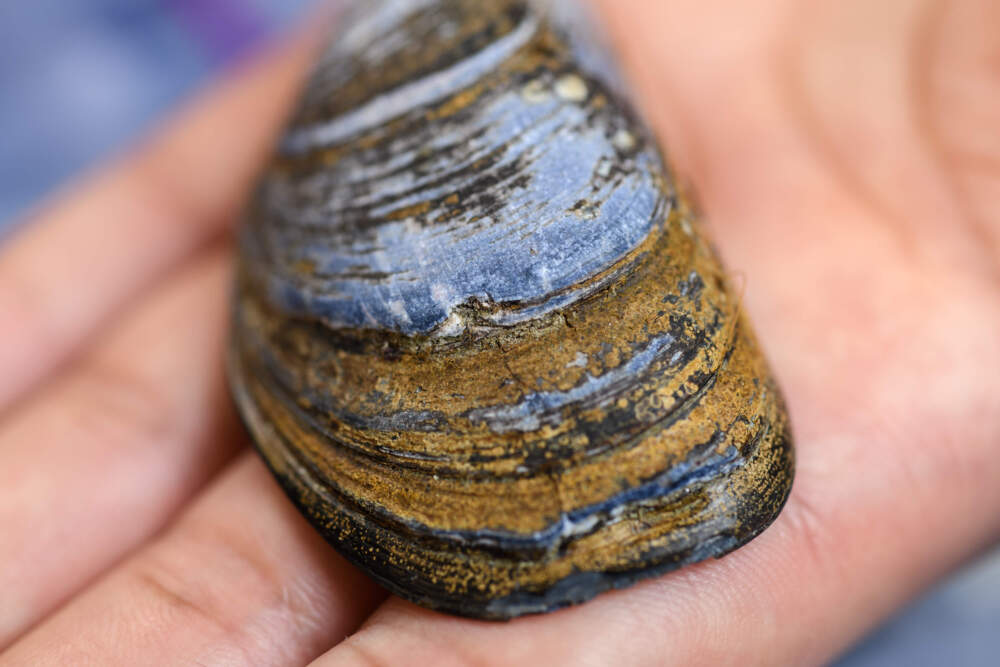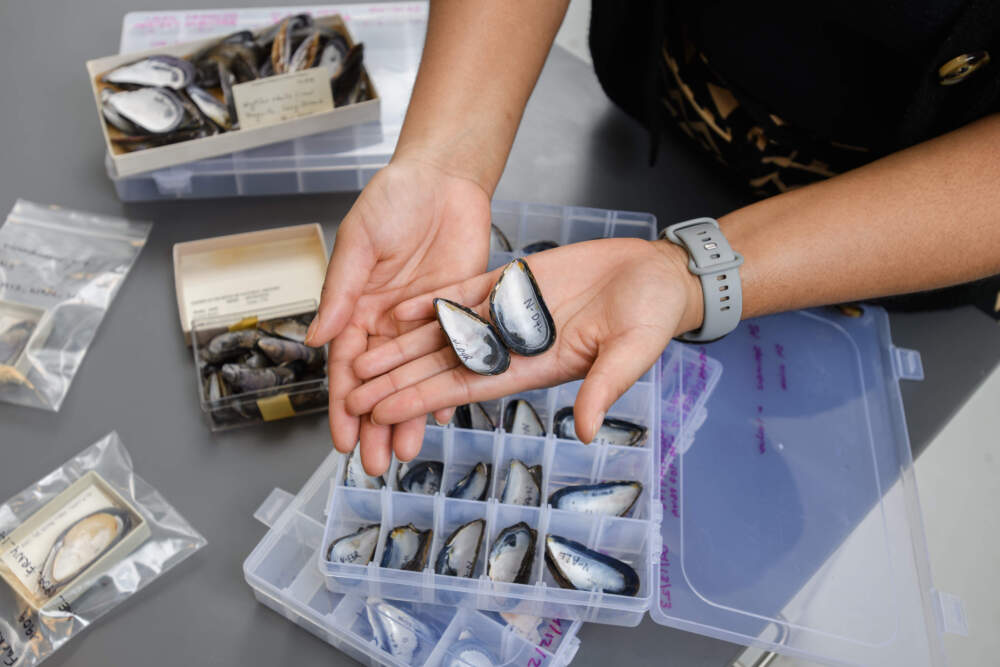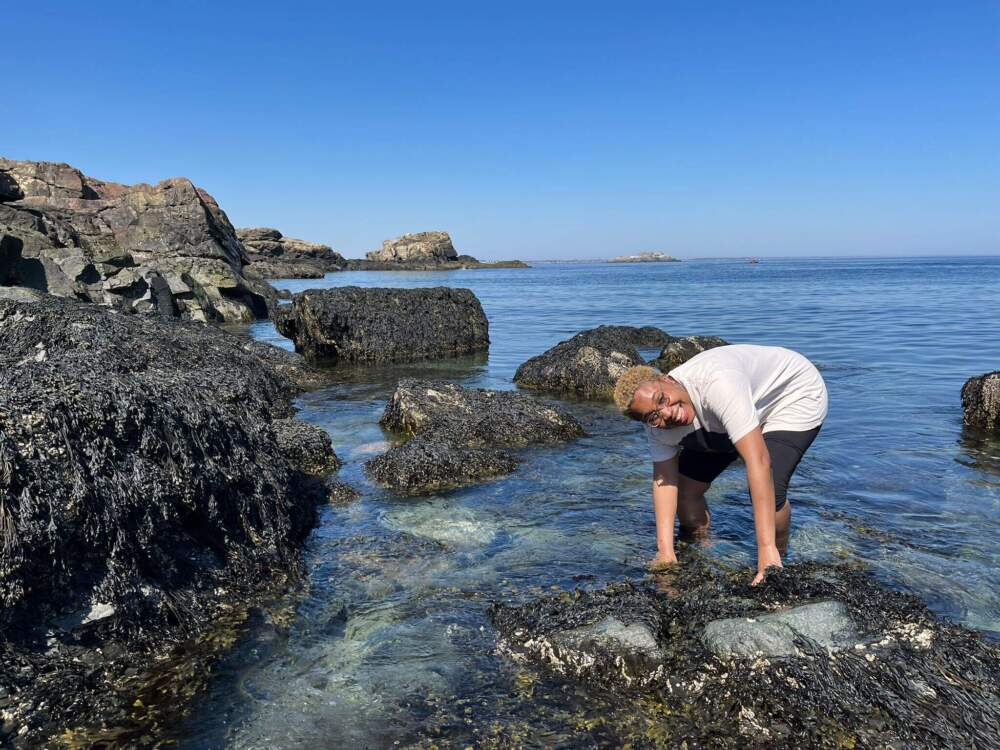Advertisement
Mussel shells are changing as the ocean warms, study finds

In Massachusetts, common blue mussels may not have the star power of Wellfleet oysters or the charisma of quahogs. But like all shellfish they play an important role in marine ecosystems. Mussels are filter feeders that clean water as they eat; and they clump into reefs that create habitat for other critters and buffer coasts from storms.
But mussels are threatened by the warming waters and ocean acidification arriving with climate change. New research shows that mussels from several East Coast locations, though not yet Massachusetts, have shells speckled with tiny holes — far more than the mussels of yesteryear.
This increased porosity is not enough to weaken the shells, yet, “but if we continue down this route, they might get there,” said study author Leanne Melbourne, a postdoctoral researcher at the American Museum of Natural History, who used historic mussel shells from museum’s collections for the study.

Melbourne, who studies the impact of climate change on marine organisms, said that ocean warming is the “most likely driver” of the increased porosity.
“If you want to maintain the structural integrity of these mussels, we need to think about how can we decrease our carbon emissions to slow down the warming,” she said.
Shellfish use calcium and carbonate from the ocean to grow shells. As the water becomes more acidic — which happens as the ocean absorbs increasing amounts of carbon dioxide — building the shell becomes more difficult. Laboratory experiments have shown that more acidic or warmer water can weaken animals’ shells, making them thinner or more porous.
Wild shellfish also face additional stressors from climate change, like marine heat waves, stronger storms and increasing prevalence of shellfish diseases. So “it's not surprising that you would see morphological changes in the shells,” said Bob Chen, a professor of marine biogeochemistry and interim dean of the School for the Environment at the University of Massachusetts, Boston.
Chen said that the region’s shellfish might evolve some resilience against these threats, “but oftentimes, the multiple stressors are too much to handle.”
For her study, Melbourne looked at shells collected in the early 1900s and the 1960s from five sites: Nahant Bay in Massachusetts, the southern end of Cape Cod, the tip of the Long Island Sound, western Long Island Sound, and New York Harbor. She then compared historic specimens with modern samples from the same sites, looking at three factors that might affect a shell’s strength: shape, thickness and porosity.
She found that modern shells collected from New York, New Jersey and Long Island Sound are more porous than older shells, sometimes significantly so. However, modern shells from Massachusetts showed no difference in porosity.
Melbourne thinks warmer water led to the increased porosity in the more southern sites. And she has an idea about why Massachusetts has been spared, so far: while the North Atlantic has experienced seasonal temperature increases of up to 5.4 degrees Fahrenheit since 1902, the warming has been uneven.

In Massachusetts, the largest temperature changes have been evident during the winter. “And the mussels aren't growing in the winter,” said Melbourne. But around New York, the largest temperature changes have been seen in the summer. “So that temperature change is actually affecting their growth.”
Melbourne also said that the early historical samples in Massachusetts already had higher porosity than other historical samples. “We don't really know exactly why that is,” she said, but “there is something maybe going on up in Massachusetts that's a little bit different.”
This doesn’t mean that Massachusetts mussels have been spared the consequences of climate change, however.
Mussels are not a huge commercial fishery in Massachusetts, but state biologists use them as a valuable “sentinel species” to monitor for diseases and contaminants that could impact public health.
“They tend to take things up and accumulate them in their tissues in real time, so they're a good sentinel species for the current quality of the surrounding water,” said Chrissy Petitpas, shellfish program leader with the Massachusetts Division of Marine Fisheries.
Petitpas said that her team has taken samples from natural mussel beds in the intertidal zone for public health monitoring for years, but now those mussels are disappearing.
“All along the Cape Cod Canal used to have mussels — we just don't see that anymore,” she said. So, her team has started gathering mussels from deep water, and putting them closer to shore for monitoring.
But even these mussels, safe from predators in cages, often can’t survive increasingly hot summers in shallow water, Petitpas said.
“As soon as we start hitting late July, August, when we have the peak water temperatures, we're going back and our stocked mussels have died,” she said.
Massachusetts Climate Chief Melissa Hoffer said she’s been “obsessed” with rapid ocean warming ever since the ocean temperatures jumped up in 2023. “It is an incredible red flag that the ocean is waving at us right now,” Hoffer said. “It's really, really dire and it's super, super urgent.”
Global sea temperatures in 2024 are on track to be the warmest in recorded history.
